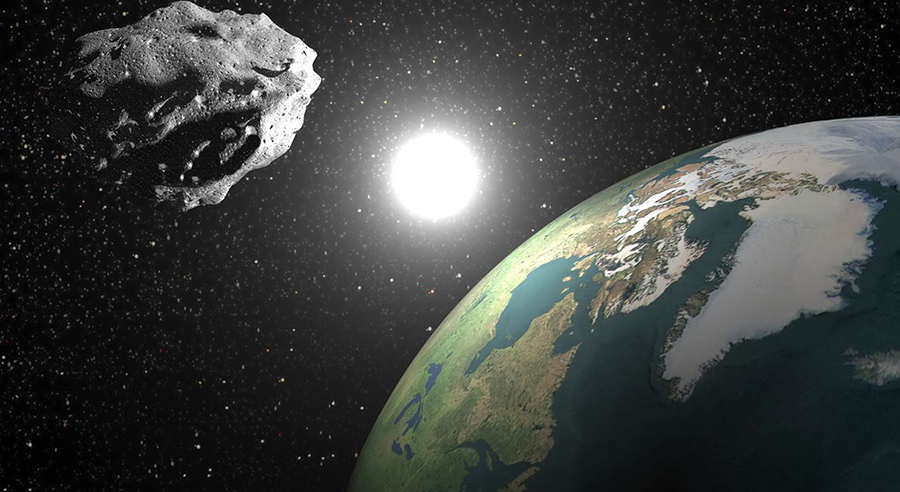NASA experts just informed that an asteroid will pass extremely near from us today, December 28. According to the information that the National Aeronautics and Space Administration recently released, the celestial boulder named by the experts as 2017 YZ4 will fly even closer than the moon, but won’t cause any damage to our world.
Professionals believe that we’re actually lucky. The fact that NASA could only spot the asteroid three days ago means that, if it were heading to the Earth, no one would have been able to do something to protect our world.
Fortunately, 2017 YZ4 – which only measures between 22.6 to 49 feet in diameter, or 7 to 15 meters, but would also provoke considerable damage – will not even touch Earth’s atmosphere, nor any further.
According to the space agency, this rock will pass by our planet 4:56 pm GMT (11.56 ET) this afternoon.

This time, at least, any asteroid will not hit our planet. The recently-discovered rock will pass between the moon and the Earth – precisely 139,433 miles (224,000 km) from us. This distance is enough to be considered a “near miss,” as NASA said.
Even at its closest, the rock won’t get closer than 0.00150 astronomical units—or about 139,433 miles (224,396 km).
The astronauts dubbed 2017 YZ4 as a potentially “hazardous” asteroid. According to them, the space agency categorizes any rock like that if it passes at least 4,600,000 miles (7,403,00 km) near from us.
Just to have a reference: there are 238,855 miles (384,400 km) between Earth and our natural satellite.
Potentially dangerous
The first time that astronauts spotted 2017 YZ4 was on Christmas day, at the Mount Lemmon Survey Observatory, in Arizona. As the space agency informed, this one will be the 52nd asteroid that passes this year between our planet and the moon.
Anything that NASA acknowledges as a near-Earth object is closer than 6 million miles to us – therefore, potentially damaging to our world. Although cosmic objects have their own orbits, which are measured by the experts, there’s always a tiny probability that something unexpected could happen.
“As of December 25, there are 17,506 known Near-Earth Objects (NEOs), in orbits around the Sun that could come close to our planet; 17,400 are asteroids and 106 are comets,” Lindley Johnson, Planetary Defense Officer at NASA’s Science Mission Directorate in Washington, D.C, told Newsweek. “This year, we’ve discovered 1,996 Near Earth Asteroids so far. There were 1887 such objects discovered in 2016 and 1,566 in 2015.”

If the rock were flying to us, there would not be much to do. The scientists explained that NASA wouldn’t be able to deflect the asteroid but only to alleviate the crash and inform people about the measures they should take to protect themselves and their properties – including to evacuate the zone of impact and to move important infrastructure.
Something similar happened in February 2013, in Russia. An asteroid of 19 meters exploded while flying over Chelyabinsk. The energy it released was so immense that experts estimated it of around 500,000 tons of TNT. Unfortunately, more than 1,000 people suffered damages.
What’s important for the scientists to know are the features and characteristics of the galactic objects. If they were heading to the Earth, and the team studied the orbit trajectory, size, shape, mass, composition, and rotational dynamics, they would be able to have a more complex plan to deal with the damages caused at the time of land.
Still: the most important thing will always be to know about any threat as soon as possible.
Constantly coming to us
Objects from space usually get close to the Earth without hitting the planet. Just a few of them tend to head land, and they’re regularly spotted. To make sure that everybody takes their own precautions, NASA’s Jet Propulsion Laboratory compiles an updated list of upcoming new-Earth asteroids.
There are a thousand of thousands of celestial objects that are still undiscovered, as Johnson explained. According to him, we can’t call them “new” because they’ve been flying throughout space for “many millennia.” However, the humanity hasn’t discovered them all “yet.”

To face this, NASA is planning new strategies to battle any celestial object rapidly coming toward us. The space agency is currently developing a spacecraft as small as a refrigerator, which will be tested with a tiny asteroid in 2024.
What would let the Double Asteroid Redirection Test (DART) to deflect the asteroids is its kinetic impact technique, which would make the object slower and less threatening. Thus, also giving Earth’s population more time to take the necessary precautions.
We will have to wait for new information about the 2017 YZ4 and how this asteroid helps NASA to prevent new upcoming asteroids.
Source: NASA
